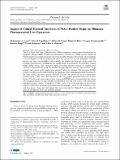| dc.contributor.author | Azad, Mohammad A. | |
| dc.contributor.author | Capellades, Gerard | |
| dc.contributor.author | Wang, Allison B. | |
| dc.contributor.author | Klee, David M. | |
| dc.contributor.author | Hammersmith, Gregory | |
| dc.contributor.author | Rapp, Kersten | |
| dc.contributor.author | Brancazio, David | |
| dc.contributor.author | Myerson, Allan S. | |
| dc.date.accessioned | 2021-09-20T17:41:42Z | |
| dc.date.available | 2021-09-20T17:41:42Z | |
| dc.date.issued | 2021-03-11 | |
| dc.identifier.uri | https://hdl.handle.net/1721.1/132056 | |
| dc.description.abstract | Abstract
The U.S. Food and Drug Administration (FDA) emphasizes drug product development by Quality by Design (QbD). Critical material attributes (CMAs) are a QbD element that has an impact on pharmaceutical operations and product quality. Pharmaceutical drugs often crystallize as needle-shaped (a CMA) particles and affect the process due to poor flowability, low bulk density, and high compressibility, and eventually the product performance. In this study, the product obtained from crystallization was needle-shaped Ciprofloxacin HCl (CIPRO), formed lumps during drying, and compacted during processing through feeders. To delump small amounts of materials and break the needles, multiple available devices (mortar-pestle, Krups grinder) and custom-made grinder were assessed before formulation. The processed CIPRO powder was then used to make tablets in the miniature tablet manufacturing unit developed by the team at MIT. The critical quality attributes (CQA) of the tablets, set by the United States Pharmacopeia (USP), were then assessed for the drug powder processed with each of these devices. Powder properties comparable to commercial CIPRO were obtained when the custom MIT-designed grinder was used, leading to tablets that meet the USP criteria, with comparable dissolution profiles of those for marketed CIPRO tablets. This study demonstrates how needle-shaped crystals have an impact on pharmaceutical operations, even if it is on a miniature scale, and how proper shape and subsequent flow properties can be obtained by processing the particles through the MIT team-designed grinder.
Graphical Abstract | en_US |
| dc.publisher | Springer International Publishing | en_US |
| dc.relation.isversionof | https://doi.org/10.1208/s12249-020-01915-6 | en_US |
| dc.rights | Creative Commons Attribution | en_US |
| dc.rights.uri | https://creativecommons.org/licenses/by/4.0/ | en_US |
| dc.source | Springer International Publishing | en_US |
| dc.title | Impact of Critical Material Attributes (CMAs)-Particle Shape on Miniature Pharmaceutical Unit Operations | en_US |
| dc.type | Article | en_US |
| dc.identifier.citation | AAPS PharmSciTech. 2021 Mar 11;22(3):98 | en_US |
| dc.contributor.department | Massachusetts Institute of Technology. Department of Chemical Engineering | |
| dc.identifier.mitlicense | PUBLISHER_CC | |
| dc.eprint.version | Final published version | en_US |
| dc.type.uri | http://purl.org/eprint/type/JournalArticle | en_US |
| eprint.status | http://purl.org/eprint/status/PeerReviewed | en_US |
| dc.date.updated | 2021-03-14T05:08:24Z | |
| dc.language.rfc3066 | en | |
| dc.rights.holder | The Author(s) | |
| dspace.embargo.terms | N | |
| dspace.date.submission | 2021-03-14T05:08:24Z | |
| mit.license | PUBLISHER_CC | |
| mit.metadata.status | Authority Work and Publication Information Needed | |
